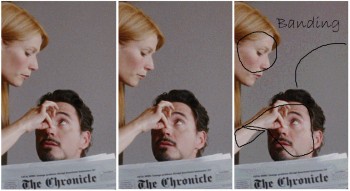I
sure i most defiantly don't know the term banding which you may have imagined but i sure know what is color banding which the last image exhibits and which you may never understand.
The person who posted the orginal pic in AVS says this:
Third one is image with bit depth reduced to 4bit/channel. Notice color banding.
 http://upload.wikimedia.org/wikipedia/commons/9/9a/Colour_banding_example01.png
http://upload.wikimedia.org/wikipedia/commons/9/9a/Colour_banding_example01.png
The first pic has a lot of banding, second one is dithered to make the banding less apparent, this is precisely what the original poster of the pic tried to do with the third pic and he himself explained that in bold using easily understandable English.
Unwanted posterization, also known as banding, may occur when the color depth, sometimes called bit depth, is insufficient to accurately sample a continuous gradation of color tone. As a result, a continuous gradient appears as a series of discrete steps or bands of color hence the name. When discussing fixed pixel displays, such as LCD and plasma televisions, this effect is referred to as false contouring.[1] The result may be compounded further by an optical illusion, called the Mach band illusion, in which each band appears to have an intensity gradient in the direction opposing the overall gradient. This problem may be resolved, in part, with dithering.
source :
Who am i kidding, you always have posted so much nonsense.May be you have our banding theory which the rest of the world may not agree.I bet you own an LCD which could suffer from clouding and banding which may not be banding according you and your little world.





